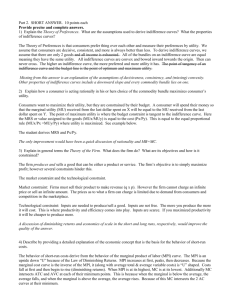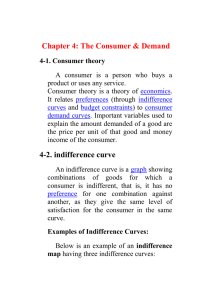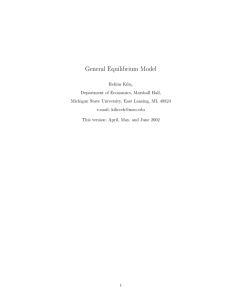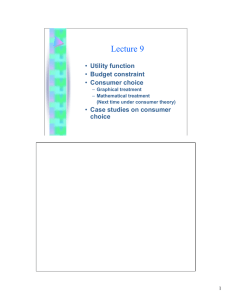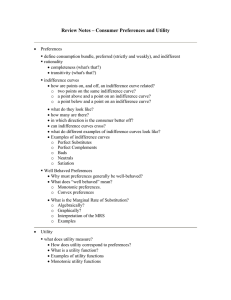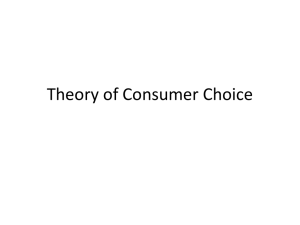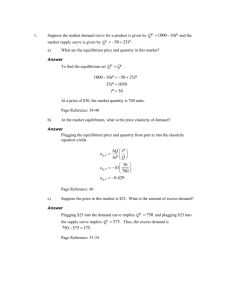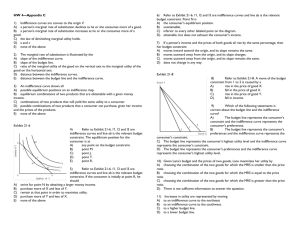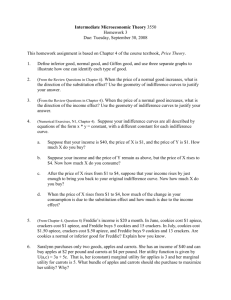Introduction to the Gains from Trade
advertisement
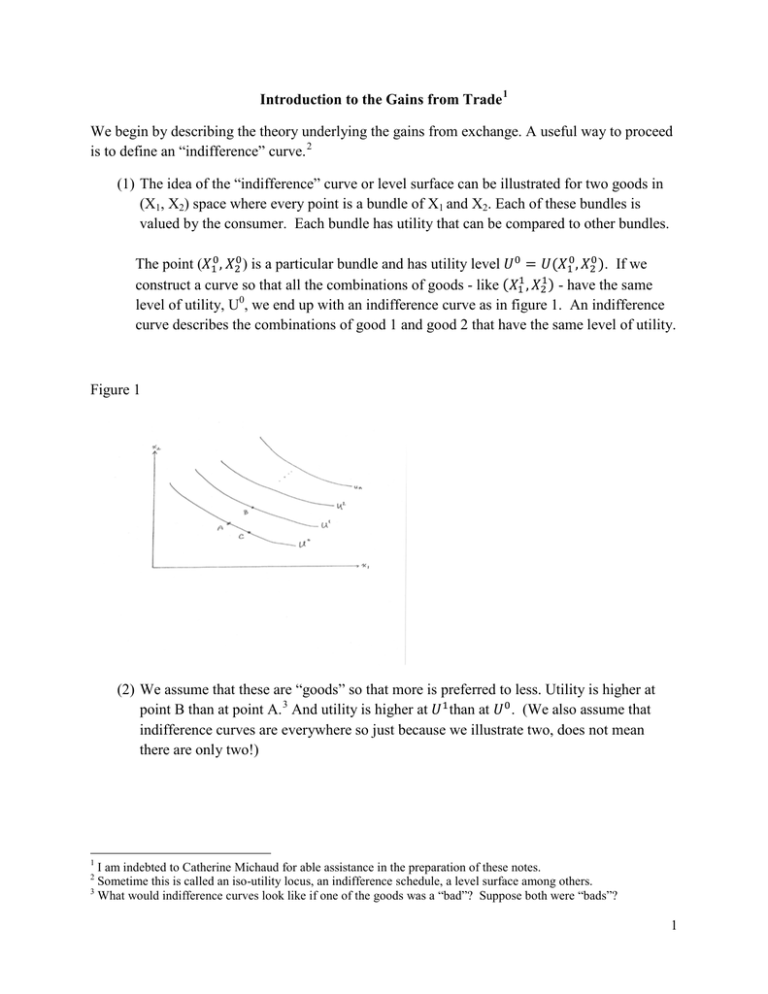
Introduction to the Gains from Trade 1 We begin by describing the theory underlying the gains from exchange. A useful way to proceed is to define an “indifference” curve. 2 (1) The idea of the “indifference” curve or level surface can be illustrated for two goods in (X1, X2) space where every point is a bundle of X1 and X2. Each of these bundles is valued by the consumer. Each bundle has utility that can be compared to other bundles. The point (𝑋10 , 𝑋20 ) is a particular bundle and has utility level 𝑈 0 = 𝑈(𝑋10 , 𝑋20 ). If we construct a curve so that all the combinations of goods - like (𝑋11 , 𝑋21 ) - have the same level of utility, U0, we end up with an indifference curve as in figure 1. An indifference curve describes the combinations of good 1 and good 2 that have the same level of utility. Figure 1 (2) We assume that these are “goods” so that more is preferred to less. Utility is higher at point B than at point A. 3 And utility is higher at 𝑈1 than at 𝑈 0 . (We also assume that indifference curves are everywhere so just because we illustrate two, does not mean there are only two!) 1 I am indebted to Catherine Michaud for able assistance in the preparation of these notes. Sometime this is called an iso-utility locus, an indifference schedule, a level surface among others. 3 What would indifference curves look like if one of the goods was a “bad”? Suppose both were “bads”? 2 1 Figure 2 (3) Comparing two points (A and C) along a line of constant utility in figure 2, we recognize that to keep utility constant when we move from A to C, we have to reduce our consumption of X1 to increase our consumption of X2. (4) In figure 2 we also assume that utility curves are bowed-in toward the origin (a convenience) and that:: 𝑈0 < 𝑈1 < 𝑈2 < ⋯ < 𝑈𝑛 , (a necessity), and that utility curves do not cross. 4 Relative Prices Suppose that a person or a country is endowed with a certain amount of X1 and X2: (𝑋10 , 𝑋20 ) at point A in figure 3. This means that their ‘utility’ or income is 𝑈0 . Now consider a set of relative prices for goods. Since a price is a measure of the opportunity cost, what you have to sacrifice to obtain a unit of the particular good, there is only one relative price in our two-good framework 𝑝 𝑝 although it can be expressed in different ways: � 1�𝑝2 � (or � 2�𝑝1 �). The relative price is represented by the line in the figure going through the point A. 4 What would it mean if indifference curves were bowed out away from the origin? Would it be consistent with the observation that we would consume both goods? What would it mean if indifference curves crossed? 2 Figure 3 • • • • Notice that the slope of the line is the relative price that answers the question: How much of good 2 must I give up to get an additional unit of good 1? We express that by calling it the relative price of good 1. The slope of the line is negative since I have to give up good 2 to get more of good 1. ∆𝑋2 is the amount of good 2 that I have to give up to get an additional unit of good 1: ∆𝑋1 . Since we know that rise-over-run is the definition of the slope of any line, prices are described by: − price. ∆𝑋2 ∆𝑋1 𝑝 1 = �𝑝1 � = � 𝑝2 � which emphasizes that there is only one relative 2 𝑝1 Income If point A in figure 4, describes our income, what do we mean by an increase in income in this framework? 5 A useful definition of an income increase is that there is a parallel outward shift in 5 Income is a definition. Our characterization of income based on the endowment of goods and the indifference curve makes it easier to examine changes in income than the usual consumer demand approach that measures money income on one axis and the good being consumed on the other axis. This reflects the difference between trade theory that takes countries as consuming both goods which they may either demand from or supply to the market. 3 a budget line. For example, in figure 5 if the budget line moves from line l0 to line l1, we would term that an increase in income. The definition reflects the idea that the opportunity set for consumption is larger along l1 than along l0. This definition tells us that at constant relative prices (the same slope), an increase in income means that more of either or both of the commodities can be consumed. Figure 4 The Classical Form of the Budget Constraint 6 The classical form of the budget constraint refers to an environment where we ignore the presence of saving (and the consequent inter-temporal issues of consumption and accumulation – these are treated more fully in Economics 345.) Thus we write: Demand (consumption) = Supply Or, in the notation that identifies consumption demand as “D’s” and production with “x’s”: 1. 𝑝1 𝐷1 + 𝑝2 𝐷2 = 𝑝1 𝑥1 + 𝑝2 𝑥2 . With two goods there is only one relative price which can be arbitrarily written as 𝑝 = that good 1 is the numeraire 7: 𝑝2 �𝑝1 so 2. 𝐷1 + 𝑝𝐷2 = 𝑥1 + 𝑝𝑥2 The usual consumer theory is not as interested in the supply of goods in the consumer’s demand. It is a matter of convenience and ease of exposition to decide which approach to adopt. 6 Much of this section is derived from Richard E. Caves and Ronald W. Jones, World Trade and Payments (Little Brown, various editions.) 7 The numeraire is arbitrary. That is, nothing substantive would change should we choose good 2 as the numeraire so that relative price would be p1. 4 Suppose (arbitrarily) good 2 is imported. This means that the demand for good 2 is greater than the supply8: 𝐷2 − 𝑥2 > 0, and if we rearrange equation 2 we can see that the value of imports, good 2, is equal to the value of exports, good 1. 3. 𝑝(𝐷2 − 𝑥2 ) = (𝑥1 − 𝐷1 ) Sometimes this is written as 𝑝𝑝 = 𝑋. For future reference we might also note that in the foreign country, the same sets of relationships hold except that the foreign country imports good 1 and exports good 2. An Increase in Real Income We defined a parallel shift in the budget line from l0 to l1 as an increase in real income. In the context of the budget constraint we have consumption as 𝐷1 + 𝑝𝐷2 so that an increase in real income, dy, (where the lower case “d” means for small changes) becomes: 4. 𝑑𝑑 ≡ 𝑑𝐷1 + 𝑝𝑑𝐷2 Recall that the definition of real income is for a parallel shift in the budget line which means that relative prices are held constant. This does not mean that income changes are always associated with constant prices, only that the definition of income is for an increase in the consumption set characterized by a parallel shift in consumption opportunities. More about this later. An Endowment Model Now we develop the first fundamental proposition of trade theory: trade can only make you better off than no trade (or at least no worse off). Consider that you are endowed with a fixed amount of goods 1 and 2 at point A. We will call point A the autarky point which means that there is no trade if you only consume the goods available at A. 8 Naturally demand and supply are functions of income and price among other things. For the present it is useful to suppress the arguments of the different functions in the notation. 5 Figure 5 Your relative prices at point A reflect the tastes embedded in the slope of the indifference curve, 𝑈0 . At point A the tangent to 𝑈0 reflects your desired tradeoff between the two goods and is the implicit price ratio depicted by l0. 𝑈0 is the same as real income, y0. Price changes from Autarky Now consider if the relative price of good 1 rises to l1. If we can choose another point along the new budget constraint, we would choose to move from autarky at point A to free trade at the point T, the point of highest income along the new budget line l1. In doing so notice that we are now increasing our consumption of good 2 and reducing our consumption of good 1. Why? Because given our tastes are reflected in the shape of the indifference curves and the new budget constraint l1, we prefer the combination of goods at T with higher utility, 𝑈1 . To reach point T we have exported good 1 and imported good 2. Is this just an artifact of choosing to import good 2 and export good1 or does what we import and export depend on relative prices? Draw a new relative price line passing through A that indicates a lower price of good 1. Show that in this case we are exporting good 2 and importing good 1. Notice further that income increases in this case as well. Thus we have developed the proposition: Free trade is always at least as good as autarky. That is, free trade it is better than autarky unless the prices between countries is the same in which case there will be no trade and you are only as well off as you were at autarky. 6 Price Changes in a Trading Environment Now, moving from autarky to free trade makes you (usually) better off, but all is not roses! You can still be hurt in a trading environment. In particular your stance in the market, whether you are an importer or an exporter, will determine whether you gain or lose when prices change. To see this, and ultimately more importantly to see it quantitatively, go back to our budget constraint 2: 𝐷1 + 𝑝𝐷2 = 𝑥1 + 𝑝𝑥2 and differentiate it totally (the small “d” can be read as “ a small change in” so that dx means “a small change in x.”: 5. 𝑑𝐷1 + 𝑝𝑝𝐷2 + 𝐷2 𝑑𝑑 = 𝑑𝑥1 + 𝑝𝑝𝑥2 + 𝑥2 𝑑𝑑 However, since we know from our definition of income that 𝑑𝑑 ≡ 𝑑𝐷1 + 𝑝𝑑𝐷2 , and that in an endowment model there is no change in the production of either good 1 or good 2: 𝑑𝑥1 = 0 and 𝑑𝑥2 = 0, we are left with: 6. 𝑑𝑑 = −(𝐷2 − 𝑥2 )𝑑𝑑 = −𝑀𝑀𝑀 Thus, if we are importers of good 2 and the price falls, our income rises. If the price of good 2 rises, then our income falls. Show that if we are exporters of good 2 and the price rises our income will rise. Don’t forget that if good 2 is exported, then 𝑥2 − 𝐷2 > 0. Generally: Your stance in the market as an importer or exporter explains whether your income rises or falls with a price increase. Similarly your gain or loss is also proportional to the size (often termed the volume) of your trade (either imports or exports). Percentage Changes: We can put this discussion into broader terms by working with percentage changes so that we are not bound by currency or commodity values. Recall that the percentage change in a variable, x, is dx/x. Thus if we write 6 as: 7 𝑑𝑑 7. 𝑑𝑑 = −𝑀𝑀𝑀 = −𝑀𝑀 � 𝑝 � We have the change in income equal to the value of imports times the percentage change in relative prices. Looking next to the percentage change in income: 8. 𝑑𝑑 𝑦 = −� 𝑝𝑝 𝑦 𝑑𝑑 � � 𝑝 �. Thus the percentage change in income is equal to the percentage change in prices time the share of imports in income. The importance of this relationship is fundamental since unlike many of the intermediate steps, it is easily found empirically. Thus we have a simply rule of thumb to predict the effect of price changes on income. How do price changes take place? Of course there are changes in the terms of trade (relative prices) arising from markets all the time. And, too, as we shall see, changes in government policy such as tariffs and quotas also generate price shocks. 8
